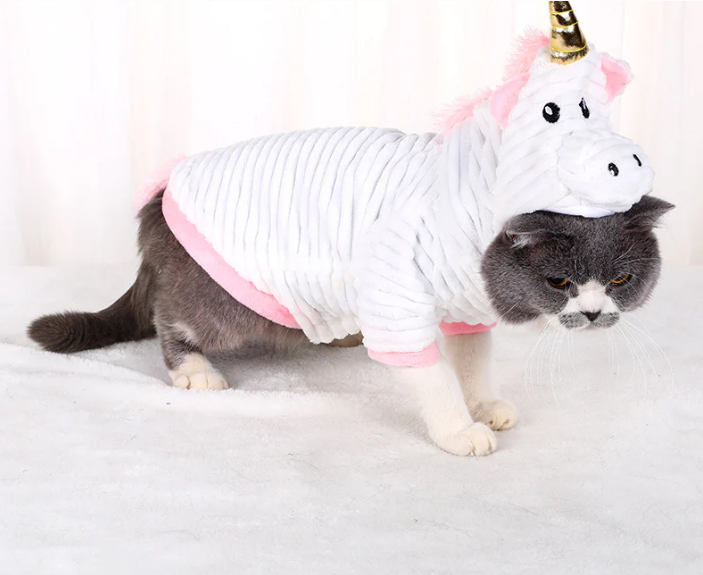Cats have been part of human civilization for as long as we have existed as we raise them, just as we raise our own children. To max out their cuteness and make them even more adorable than they are, we put them in tiny, colorful clothes designed especially for them.
If you are in the market for new cat clothes and you just don't know what to get your feline best friend, then you are in the right place. This article explores what makes up good cat clothes and outlines tips that will ensure you get the best cat clothes from the vast options available. We also provide tips on what to avoid while shopping for cats dress, as the last thing a pet owner wants is to make their little feline friend uncomfortable. Let's look at some things you should consider when buying cat clothes.
What material should a cat's clothes be made from?
Most of the clothing available for cats is produced from low-quality materials. Most synthesized textiles tend to really be scratchy, restrict movement significantly, and are often permeable.
Premium textiles that allow air to pass through them are ideal for making cat clothing since they are as permeable as the fabrics utilized to make clothes for people. Please stay away from wool as well, even though it looks great on your garments. Felines may find it irritating as it often offers an excessive amount of warming for the furred creatures. Here are a few materials that make the best cat clothes:
Cotton
Without a doubt, cotton is the best option when it comes to pet clothing. It is organic, permeable, adaptable, and really cleanable, on top of all those other benefits. It is available in various densities, so you should search for products created using ultra-light cotton.
Spandex
Spandex offers the cat flexibility and ease of joint mobility, which goes a long way in making the cat comfortable. When a cat's clothing is made up of a blend of spandex and another lighter material, it reduces the strain the spandex might have on the cat's body while still keeping the cloth stretchable.
Polyester
Polyester clothes are ideal for cats with no fur or those with little fur, as they can provide the cat with the additional warmth needed when the temperature drops. Although most people dress their cats to make them look stylish or for photo shoots, some cats genuinely need clothes for the same reason we do: warmth. A polyester/cotton jackets for cats will give your furless cat enough insulation from the cold to keep her happy and comfortable through winter, while still maintaining permeability to keep the cat from overheating.
Size of the clothing
Pick out garments for your cat that are proportionate to its body structure so it can feel at ease. Actually, measure the size of the cat's body or get some expert to do it for you if you are getting a custom job or are generally unsure of what measures are essential. It will ensure that you get fitting apparel for your little friend because comfort is key.
If you get your cat clothes that fit too tight or are too big for it, it might change its behavior and even get irritated and start lashing out. Cats are very sensitive creatures, and if they feel the weight of your clothes weighing them down, they will let you know. The clothing size will ultimately decide whether the cat wants it or not.
Safety
Cats are curious animals, and if they see a loose thread on their clothing, they will pull it. This may ruin the dress, or worse, it may hurt the cat itself. Since they have claws, ensure the clothes you get for your cat are claw-proof to some extent, or at least the threads don't get loose quickly. It will significantly depend on the material the cloth is made of.
Also, ensure the cloth is fully intact and there are no tags, beads, or buttons that your cat could potentially eat and end up getting choked. The materials mentioned above are considered safe for cats because they are generally not too constraining and don't irritate their skin. Avoid synthetic fabrics, rubber, plastic, and other abrasive materials, especially when selecting sweaters for kittens.
Do cats need clothes?
Most cat clothes are not designed or meant for casual wear, which makes sense since cats have fur and work really well at keeping the cat warm. But, as mentioned above, some cats may require additional warmth when the weather gets too cold for their biological heating mechanisms to work. Some cats don't even have fur to keep them warm, so they definitely need clothes.
If you find that your cat doesn't want to wear clothes, or if it gets really annoyed after you dress it, you might want to reconsider the type of cloth you got the cat. Cats get warm fast, and your pet may be too uncomfortable from all the heat.
If you are sure that the cloth is breathable and cool, then don't force them into it. Instead, start off really small by putting a bandana or a simpler cloth on the cat first. It might ease the transition to having an entire body covering. If that doesn't work, maybe your feline friend is just not cut out to wear clothes.
Another thing to consider before donning your cat a dress is her age. While adult cats might behave okay within a garment, kittens might struggle with the clothes or even get tangled up, which might make you think they hate the clothes when they are just too young to handle them.
Conclusion
With all that in mind, buying cat clothes will be a breeze when you factor in your own sense of style when selecting the best clothes for your feline friend. Remember, if you intend for the cat to wear the clothes for a long time, comfort always comes first.

